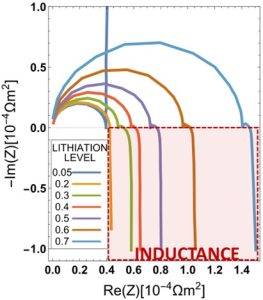Researchers from the Faculty of Mechanical Engineering, Laboratory for Internal Combustion Engines and Electromobility (LICeM) have, in collaboration with the Denmark Technical University (DTU), for the first time calculated the full electrochemical impedance spectrum of the LiFePO4 nanoparticle, which is one of the most commonly used materials in lithium-ion batteries. Striking result, which shows the strongly inductive behaviour of a phase separating nanoparticle in the low-frequency part of the spectrum (figure), is published in the prestigious journal Energy Storage Materials (IF: 20,831).

Electrochemical impedance spectroscopy (EIS) is a very effective non-invasive method for the analysis of many different systems. Adequate interpretation of impedance spectra measured by the EIS method inherently relies on an accurate mathematical model of the analysed system. Researchers have developed the mathematical model for the analysis of the impedance spectra based on the phase field theory. The physicochemically consistent model has enabled unprecedented virtual insight into the phenomenology of processes characteristic for the so-called chemical inductor, a recently discovered phenomenon. The researchers have also interlinked the result of the mechanistically based model of the phase separating material to the hitherto unexplained experimental observations published in the literature, which further reinforces significance of published discovery.
Published results have a significant impact on the understanding of the electrochemical processes of phase separating materials and also on the interpretation of spectra of phase separating materials measured by the method of impedance spectroscopy. Both impacts additionally contribute to a more efficient model-based prediction of states in batteries made from phase separating materials.
Link to the article: https://doi.org/10.1016/j.ensm.2023.01.008.